Zircon Isotopic Constraints on Age, Magma Genesis, and Evolution of the Betic Ophiolites, Nevado-Filábride Complex, Spain
Abstract
1. Introduction
2. Geological Setting
3. Petrological Characterization of the Betic Ophiolites
4. Geochemistry of the Betic Ophiolites
4.1. Chemical Composition of the Betic Ophiolites and Their Tectonic Setting
4.2. Magmatic and Temporal Relationships Among the Dated Rocks from Cóbdar and Algarrobo Compared with Those from Lugros and Almirez
5. Zircon Study with SHRIMP
5.1. SHRIMP U-Pb Data Results for Zircons from Cóbdar and Algarrobo
5.2. Geochemistry of the Jurassic and Locally Pre-Jurassic Zircons of the Betic Ophiolites
5.3. Oxygen Isotope Ratios in Magmatic Zircons of the Betic Ophiolites
5.4. Trace Elements Geochemistry of Zircons of the Betic Ophiolites
6. Development and Evolution of the Betic Tethys
7. Conclusions
- Petrological and geochemical analyses of the metabasic rocks within the Betic ophiolites reveal the MORB affinity of their various igneous lithotypes. These include olivine–pyroxene gabbros, dolerites, and basalts, as identified in all four studied outcrops: Lugros, Almirez, Cóbdar, and Algarrobo.
- Their zircons, dated by U-Pb with SHRIMP and ranging in age from the Lower to the Middle Jurassic, have also allowed us to distinguish several magmatic levels in the Cóbdar and Algarrobo outcrops, as well as a formation period for the Betic oceanic floor ranging from approximately 187 to 173 Ma. This formation period was followed by the development of the overlying sedimentary sequence.
- Alongside the Jurassic zircons, pre-Jurassic xenocrystic zircon crystals, mainly of Precambrian age, were identified, primarily in samples from the Algarrobo outcrop. These xenocrysts are similar in age and chemical composition to those coexisting with modern volcanism dredged from the Mid-Atlantic Ridge (MAR) near fracture zones and from other ultra-slow ridges like the Southwest Indian Ridge (SWIR) at the Atlantic Bank. The similarity in age and chemical composition of the Precambrian xenocrystic zircon of the Betic ophiolites and those dredged from the MAR and SWIR suggests a similar tectonic setting for magmatism in both the Jurassic Betic Ocean and contemporary ultra-slow oceanic ridges.
- The δ18O isotopic ratios of zircons from the Betic ophiolites, sampled from gabbros, basalts, and dolerite dykes intruding into serpentinites, show strong similarity to values from zircons in analogous igneous rocks dredged from ultra-slow oceanic ridges, such as the MAR and SWIR.
- Additionally, some zircon crystals from the Betic ophiolites preserve local variations in their δ18O values. These variations record two distinct metamorphic events: an earlier one dated to ~150 Ma, interpreted as oceanic floor metamorphism, and later Cenozoic ages, attributed to the orogenic metamorphism that affected the host rocks.
- The chondrite-normalized REE patterns of Jurassic igneous zircons from the Betic ophiolites are consistent with those of zircons from oceanic crust. Furthermore, their more recrystallized domains, commonly found surrounding vesicles, exhibit a slight depletion in HREE and Y, alongside a local increase in LREE and Hf values. This geochemical signature is also similar to that observed in other Tethyan ophiolites.
- The interpretative location of the four studied Betic ophiolitic outcrops (Lugros, Cóbdar, Algarrobo, and Almirez) within a hypothetical reconstruction of the Jurassic Betic Ocean is based primarily on their U-Pb ages. These ages range from 187 to 180 Ma for gabbros and basalts in the first three outcrops. The dolerite dikes that intruded into the Almirez ultramafic rocks under oceanic conditions yielded an age of 184 Ma. Therefore, these ultramafic rocks were already exhumed at that time into the ocean floor, forming an oceanic core complex.
Supplementary Materials
Author Contributions
Funding
Acknowledgments
Conflicts of Interest
References
- Bouillin, J.P.; Durand-Delgá, M.; Olivier, P.H. Betic-Rifain and Tyrrenian Arcs: Distinctive features, genesis and development stages. In The Origin of Arcs; Wezel, F.C., Ed.; Elsevier: Amsterdam, The Netherlands, 1986; pp. 281–304. [Google Scholar]
- Guerrera, F.; Martin-Algarra, A.; Perrone, V. Late Oligocene–Miocene syn-/-late orogenic successions in Western and Central Mediterranean Chains from the Betic Cordillera to the Southern Apennines. Terra Nova 1993, 5, 525–544. [Google Scholar] [CrossRef]
- Puga, E.; de Federico, A.D.; Fanning, M.; Nieto, J.M.; Martínez-Conde, J.Á.R.; Puga, M.Á.D.; Lozano, J.A.; Bianchini, G.; Natali, C.; Beccaluva, L. The Betic Ophiolites and the Mesozoic Evolution of the Western Tethys. Geosciences 2017, 7, 31. [Google Scholar] [CrossRef]
- Lonergan, L.; White, N. Origin of the Betic –Rif mountain belt. Tectonics 1997, 16, 504–522. [Google Scholar] [CrossRef]
- Rosenbaum, G.; Lister, G.S.; Duboz, C. Reconstruction of the tectonic evolution of the western Mediterranean since the Oligocene. J. Virtual Explor. 2002, 8, 107–130. [Google Scholar] [CrossRef]
- Puga, E.; Nieto, J.M.; De Federico, A.D.; Nieto, J.M. Tectono-stratigraphic subdivison and petrological characterisation of the deepest complexes of the Betic Zone: A Review. Geodin. Acta 2002, 15, 23–43. [Google Scholar] [CrossRef]
- Puga, E.; Fanning, M.; de Federico, A.D.; Nieto, J.M.; Beccaluva, L.; Bianchini, G.; Puga, M.A. Petrology, geochemistry and U-Pb geochronology of the Betic Ophiolites: Inferences for Pangaea break-up and birth of the westernmost Tethys Ocean. Lithos 2011, 124, 255–272. [Google Scholar] [CrossRef]
- Vergés, J.; Fernández, M. Tethys–Atlantic interaction along the Iberia–Africa plate boundary: The Betic–Rif orogenic system. Tectonophysics 2012, 579, 144–172. [Google Scholar] [CrossRef]
- Michard, A.; Mokhtari, A.; Chalouan, A. New ophiolite slivers in the External Rif belt, and tentative restoration of a dual Tethyan suture in the western Maghrebides. Bull. Société Géologique Fr. 2014, 185, 313–328. [Google Scholar] [CrossRef]
- Platt, J.P.; Anczkiewicz, R.; Soto, J.I.; Kelley, S.P.; Thirlwall, M. Early Miocene continental subduction and rapid exhumation in the western Mediterranean. Geology 2006, 34, 981–984. [Google Scholar] [CrossRef]
- Vera, J.A.; Martín-Algarra, A. Cadenas Béticas: Divisiones mayores y nomenclatura. In Geología de España; Vera, J.A., Ed.; SGE-IGME: Madrid, Spain, 2004; pp. 348–350. [Google Scholar]
- Porkoláb, K.; Matenco, L.; Hupkes, J.; Willingshofer, E.; Wijbrans, J.; Lantman, H.; van Hinsbergen, D. Tectonic Evolution of the Nevado-Filábride Complex (Sierra de Los Filábres, Southeastern Spain): Insights from new structural and geochronological data. Tectonics 2022, 41, e2021TC006922. [Google Scholar] [CrossRef]
- Linthout, K.; Vissers, R.L.M. On the classification of tectonic units in the Nevado-Filabrjde Complex of the northern Sierra de los Filabres, Betic Cordilleras, SE Spain. Geol. Mijnb. 1979, 58, 49–56. [Google Scholar]
- Poulaki, E.M.; Stockli, D.F. The paleotectonic evolution of the western Mediterranean: Provenance insights from the internal Betics, southern Spain. Front. Earth Sci. 2022, 10, 929502. [Google Scholar] [CrossRef]
- Martínez-Martínez, J.M. Evolución tectono-metamórfica del Complejo Nevado-Filábride en el sector de unión entre Sierra Nevada y Sierra de los Filabres (Cordilleras Béticas, España). Cuad. Geol. Univ. Granada 1986, 13, 194. [Google Scholar]
- Martínez-Martínez, J.M.; Soto, J.I.; Balanyá, J.C. Orthogonal folding of extensional detachments: Structure and origin of the Sierra Nevada elongated dome (Betics, SE Spain). Tectonics 2002, 21, 1–22. [Google Scholar] [CrossRef]
- Zeijlmans van Emmichoven, C.P.A. Geologische Onderzoekingen in the Sierra de los Filabres (Provincie Almeria, Spanje). Ph.D. Thesis, University Delft, Delft, The Netherlands, 1925; p. 160. [Google Scholar]
- Brouwer, H.A. Zur Geologie der Sierra Nevada. Int. J. Earth Sci. 1926, 17, 118–137. [Google Scholar] [CrossRef]
- Fallot, P.; Faure-Muret, A.; Fontboté, J.M.; Solé Sabaris, L. Estudios Sobre las Series de Sierra Nevada y de la Llamada Minschungszone; Publicaciones del Laboratorio de Geología de la Universidad de Granada: Granada, España, 1961; p. 537. [Google Scholar]
- Laborda-López, C.; Aguirre, J.; Donovan, S.K. Surviving metamorphism: Taphonomy of fossil assemblages in marble and calc-silicate schist. Palaios 2015, 30, 668–679. [Google Scholar] [CrossRef]
- Rodríguez-Cañero, R.; Jabaloy-Sánchez, A.; Navas-Parejo, P.; Martín-Algarra, A. Linking Palaeozoic palaeogeography of the Betic Cordillera to the Variscan Iberian Massif: New insight through the first conodonts of the Nevado-Filábride Complex. Int. J. Earth Sci. 2017, 107, 1791–1806. [Google Scholar] [CrossRef]
- Nijhuis, H.J. Plurifacial Alpine Metamorphism in the Southeastern Sierra de los Filabres South of Lubrín, SE Spain. Ph.D. Thesis, University Amsterdam, Amsterdam, The Netherlands, 1964; p. 151. [Google Scholar]
- Voet, H.W. Geological Investigations in the Northern Sierra de los Filabres, Around Macael and Cóbdar, SE Spain. Ph.D. Thesis, University Amsterdam, Amsterdam, The Netherlands, 1967; p. 122. [Google Scholar]
- Poulaki, E.M.; Stockli, D.F.; Shuck, B.D. Pre-Subduction Architecture Controls Coherent Underplating During Subduction and Exhumation (Nevado-Filábride Complex, Southern Spain). Geochem. Geophys. Geosystems 2023, 24, e2022GC010802. [Google Scholar] [CrossRef]
- Puga, E. The Betic Ophiolitic Association (Southeastern Spain). Ofioliti 1990, 15, 97–117. [Google Scholar]
- Brouwer, H.A. Über die Struktur der penninischen Zone in den betischen Kordilleren. Geol. Rundsch. 1934, 25, 383–387. [Google Scholar] [CrossRef]
- Barbero, E.; Dilek, Y.; Festa, A.; Saccani, E. Ophiolites and ophiolitic mélanges: Archives of Precambrian and Phanerozoic plate tectonics in orogenic belts. Geosystems Geoenvironment 2023, 2, 100191. [Google Scholar] [CrossRef]
- Laborda-López, C.; Marchesi, C.; Sánchez-Vizcaíno, V.L.; Gómez-Pugnaire, M.T.; Dale, C.W.; Jabaloy-Sánchez, A.; Padrón-Navarta, J.A.; Román-Alpiste, M.J.; Garrido, C.J. Geochemical evolution of rodingites during subduction: Insights from Cerro del Almirez (southern Spain). Lithos 2020, 370, 105639. [Google Scholar] [CrossRef]
- López Sánchez-Vizcaíno, V.; Franz, G.; Gómez-Pugnaire, M.T. The behaviour of Cr during metamorphism of carbonate rocks from the Nevado-Filabride Complex, Betic Cordilleras, Spain. Can. Mineral. 1995, 33, 85–104. [Google Scholar]
- Tendero, J.; Martín-Algarra, A.; Puga, E.; Díaz de Federico, A. Lithostratigraphie des métasédiments de l’association ophiolitique Nevado-Filábride (SE Espagne) et mise en évidence d’objets ankéritiques évoquant des foraminifères planctoniques du Crétacé: Conséquences paléogéographiques. Comptes Rendus L’académie Sci. Série 2 Mécanique Phys. Chim. Sci. L’univers Sci. Terre 1993, 316, 1115–1122. [Google Scholar]
- López Sánchez-Vizcaíno, V.; Gomez-Pugnaire, M.T. Metamorphism of the Nevado-Filábride Complex. In The Geology of Iberia: A Geodynamic Approach; Quesada, C., Oliveira, J.T., Eds.; The Alpine Cycle: East Sussex, UK, 2019; Volume 3, pp. 530–544. [Google Scholar]
- Nieto, J.M. Petrología y Geoquímica de los Ortogneises del Complejo del Mulhacén, Cordilleras Béticas. Ph.D. Thesis, University Granada, Granada, Spain, 1996; p. 211. [Google Scholar]
- Bicker, R.E. Geological Investigations in the Region West of Antas and Cuevas del Almanzora, South-Eastern Spain. Ph.D. Thesis, University Amsterdam, Amsterdam, The Netherlands, 1966; p. 124. [Google Scholar]
- Gómez-Pugnaire, M.; Rubatto, D.; Fernández-Soler, J.; Jabaloy, A.; López-Sánchez-Vizcaíno, V.; González-Lodeiro, F.; Galindo-Zaldívar, J.; Padrón-Navarta, J. U-Pb geochronology of Nevado-Filábride gneisses: Evidence for the Variscan nature of the deepest Betic complex (SE Spain). Lithos 2012, 146–147, 93–111. [Google Scholar] [CrossRef]
- Ruiz-Cruz, M.D.; de Galdeano, C.S.; Santamaría, Á. Geochemical Signatures and Inclusions in Apatite as Markers of a Hidden Ultrahigh-Pressure Event (Betic Cordillera, Spain). J. Geol. 2016, 124, 277–292. [Google Scholar] [CrossRef]
- De la Roche, H.; Leterrier, J.; Grandclaude, P.; Marchal, M. A classification of volcanic and plutonic rocks using R1–R2 diagrams and major element analyses—Its relationships with current nomenclature. Chem. Geol. 1980, 29, 183–210. [Google Scholar] [CrossRef]
- Batchelor, R.A.; Bowden, P. Petrogenetic interpretation of granitoids series using multicationic parameters. Chem. Geol. 1985, 48, 43–55. [Google Scholar] [CrossRef]
- Pearce, J.A.; Harris, N.B.W.; Tindle, A.G. Trace element discrimination diagrams for the tectonic interpretation of granitic rocks. J. Pet. 1984, 25, 956–983. [Google Scholar] [CrossRef]
- Nieto, J.M.; Puga, E.; Díaz de Federico, A. Late Variscan pyroclastic rocks from the Mulhacén Complex (Betic Cordillera, Spain). In Volcaniclastic Rocks, from Magmas to Sediments; Leyrit, H., Montenat, C.H., Eds.; Gordon and Breach Science Publishers: Amsterdam, The Netherlnds, 2000; pp. 217–234. [Google Scholar]
- Rodríguez, J.; Pin, C.; Suárez, S.; Ortega, L.Á.; Paquette, J.L.; Ábalos, B.; Gil Ibarguchi, J.I. Hybridization of crustal magmas and direct evidence for two mantle sources during Early-Ordovician magmatism at the NW Gondwana margin. Lithos 2025, 514–515, 108171. [Google Scholar] [CrossRef]
- Martín-Algarra, A.; García-Casco, A.; Gómez-Pugnaire, M.T.; Jabaloy-Sánchez, A.; Laborda-López, C.; Sánchez-Vizcaíno, V.L.; Mazzoli, S.; Navas-Parejo, P.; Perrone, V.; Rodríguez-Cañero, R.; et al. Paleozoic Basement and Pre-Alpine History of the Betic Cordillera. In The Geology of Iberia: A Geodynamic Approach; Quesada, C., Oliveira, J.T., Eds.; The Variscan Cycle: Barcelona, Spain, 2019; Volume 2, pp. 261–305. [Google Scholar]
- Gómez-Pugnaire, M.T.; Galindo-Zaldívar, J.; Rubatto, D.; González-Lodeiro, F.; López Sánchez-Vizcaíno, V.; Jabaloy, A. A reinterpretation of the Nevado-Filábride and Alpujárride Complex (Betic Cordillera): Field, petrography and U-Pb ages from orthogneisses western Sierra Nevada, S Spain. Schweiz. Mineral. Und Petrogr. Mitteilungen 2004, 84, 303–322. [Google Scholar]
- Linthout, K. (Vrije Universiteit Amsterdam, Amsterdam, The Netherlands). Personal communication, 2009. During a field visit with Prof. Linthout we examined an outcrop of the Ophiolitic Mélange south of Macael consisting of metapelites with chromium-rich layers and containing also decimeter-sized pockets of exceptionally pure jadeite (95–98% Jd).
- Vissers, R.L.M. A structural study of the Central Sierra de los Filabres (Betic Zone, SE Spain), with emphasis on deformational processes and their relation to the Alpine Metamorphism. GUA Pap. Geol. 1981, 15, 1–154. [Google Scholar]
- Puga, E.; Cruz, M.D.R.; De Federico, A.D. Polymetamorphic amphibole veins in metabasalts from the Betic Ophiolitic Association (SE Spain): Relics of ocean-floor metamorphism preserved throughout the Alpine Orogeny. Can. Miner. 2002, 40, 67–83. [Google Scholar] [CrossRef]
- Govindaraju, K.; Potts, P.J.; Webb, P.C.; Watson, J.S. 1994 Report on Whin Sill Dolerite WS-E from England and Pitscurrie Micrograbbro PM-S from Scotland: Assessment by one hundred and four international laboratories. Geostand. Newsl. 1994, 18, 211–300. [Google Scholar] [CrossRef]
- Williams, I.S. U–Th–Pb geochronology by ion microprobe. In: McKibben MA, Shanks III WC & Ridley WI (Eds.), Applications of Microanalytical Techniques to Understanding Mineralizing Processes. Rev. Econ. Geol. 1998, 7, 1–35. [Google Scholar]
- Ludwig, K.R. SQUID 1.02, a User’s Manual; Berkeley Geochronology Center Special Publication: Berkeley, CA, USA, 2001; No. 2. [Google Scholar]
- Ludwig, K.R. User’s Manual for Isoplot/Ex Version 3.0. A Geochronological Toolkit for Microsoft Excel; Berkeley Geochronology Center Special Publication: Berkeley, CA, USA, 2003; No. 4. [Google Scholar]
- Ickert, R.; Hiess, J.; Williams, I.; Holden, P.; Ireland, T.; Lanc, P.; Schram, N.; Foster, J.; Clement, S. Determining high precision, in situ, oxygen isotope ratios with a SHRIMP II: Analyses of MPI-DING silicate-glass reference materials and zircon from contrasting granites. Chem. Geol. 2008, 257, 114–128. [Google Scholar] [CrossRef]
- Black, L.P.; Kamo, S.L.; Allen, C.M.; Aleinikoff, J.N.; Davis, D.W.; Korsch, R.J.; Foudoulis, C. TEMORA 1: A new zircon standard for Phanerozoic U-Pb geochronology. Chem. Geol. 2003, 200, 155–170. [Google Scholar] [CrossRef]
- Saccani, E.; Dilek, Y.; Marroni, M.; Pandolfi, L. Continental margin ophiolites of Neotethys: Remnants of Ancient Ocean-Continent Transition Zone (OCTZ) lithosphere and their geochemistry, mantle sources and melt evolution patterns. Episodes 2015, 38, 230–249. [Google Scholar] [CrossRef]
- Zeng, L.; Niu, H.; Bao, Z.; Shan, Q.; Li, H.; Li, N.; Yang, W. Petrogenesis and tectonic significance of the plagiogranites in the Zhaheba ophiolite, Eastern Junggar orogen, Xinjang, China. J. Asian Earth Sci. 2015, 113, 137–150. [Google Scholar] [CrossRef]
- Saccani, E. A new method of discriminating different types of post-Archean ophiolitic basalts and their tectonic significance using Th-Nb and Ce-Dy-Yb systematics. Geosci. Front. 2015, 6, 481–501. [Google Scholar] [CrossRef]
- Snow, J.E.; Hart, S.R.; Dick, H.J.B. Nd and Sr isotope evidence linking mid-ocean ridge basalts and abyssal peridotites. Nature 1994, 371, 57–60. [Google Scholar] [CrossRef]
- Sun, S.S.; McDonough, W.F. Chemical and isotopic systematic of oceanic basalts; implications for mantle composition and processes. In Magmatism in the Oceanic Basins; Saunders, A.D., Norry, M.J., Eds.; Special Publication Geological Society of London: London, UK, 1989; Volume 42, pp. 313–345. [Google Scholar]
- Rampone, E.; Hofmann, A.W.; Raczek, I. Isotopic constraints within the Internal Liguride ophiolite (N. Italy): The lack of a genetic mantle–crust link. Earth Planet. Sci. Lett. 1998, 163, 175–189. [Google Scholar] [CrossRef]
- Schaltegger, U.; Desmurs, L.; Manatschal, G.; Müntener, O.; Meier, M.; Frank, M.; Bernoulli, D. The transition from rifting to seafloor spreading within a magma-poor rifted margin: Field and isotopic constraints. Terra Nova 2002, 14, 156–162. [Google Scholar] [CrossRef]
- Cipriani, A.; Brueckner, H.K.; Bonatti, E.; Brunelli, D. Oceanic crust generated by elusive parents: Sr and Nd isotopes in basalt-peridotite pairs from the Mid-Atlantic Ridge. Geology 2004, 32, 657–660. [Google Scholar] [CrossRef]
- Jones, C.E.; Jenkyns, H.C.; Coe, A.L.; Stephen, H.P. Strontium isotopic variations in Jurassic and Cretaceous seawater. Geochimica et Cosmochimica. Acta 1994, 58, 3061–3074. [Google Scholar] [CrossRef]
- Dilek, Y.; Furnes, H. Ophiolites and their origins. Elements 2014, 10, 93–100. [Google Scholar] [CrossRef]
- Furnes, H.; Dilek, Y. Geochemical characterization and petrogenesis of intermediate to silicic rocks in ophiolites: A global synthesis. Earth-Sci. Rev. 2017, 166, 1–37. [Google Scholar] [CrossRef]
- Furnes, H.; de Wit, M.; Dilek, Y. Four billion years of ophiolites reveal secular trends in oceanic crust formation. Geosci. Front. 2014, 5, 571–603. [Google Scholar] [CrossRef]
- Puga, E.; Fanning, C.M.; Nieto, J.M.; De Federico, A.D. New recrystallisation textures in zircons generated by ocean-floor and eclogite facies metamorphism: A cathodoluminescence and U-Pb SHRIMP study with constraints from REE elements. Can. Miner. 2005, 43, 183–202. [Google Scholar] [CrossRef]
- Puga, E.; de Federico, A.D.; Demant, A. The eclogitized pillows of the Betic Ophiolitic Association: Relics of the Tethys ocean floor incorporated to the Alpine Chain after subduction. Terra Nova 1995, 7, 31–43. [Google Scholar] [CrossRef]
- Puga, E.; Nieto, J.; de Federico, A.D.; Bodinier, J.; Morten, L. Petrology and metamorphic evolution of ultramafic rocks and dolerite dykes of the Betic Ophiolitic Association (Mulhacén Complex, SE Spain): Evidence of eo-Alpine subduction following an ocean-floor metasomatic process. Lithos 1999, 49, 23–56. [Google Scholar] [CrossRef]
- Puga, E.; de Federico, A.D.; Nieto, J.M.; Puga, M.A.D.; Martínez-Conde, J.A.R. The Betic Ophiolitic Association: A very significant geological heritage in urgent need of preservation. Geoheritage 2009, 1, 11–31. [Google Scholar] [CrossRef]
- Alt, J.C.; Garrido, C.J.; Shanks, W.; Turchyn, A.; Padrón-Navarta, J.A.; Sánchez-Vizcaíno, V.L.; Pugnaire, M.T.G.; Marchesi, C. Recycling of water, carbon and sulfur during subduction of serpentinites: A stable isotope study of Cerro del Almirez, Spain. Earth Planet. Sci. Lett. 2012, 327–328, 50–60. [Google Scholar] [CrossRef]
- Tera, F.; Wasserburg, G. U–Th–Pb systematics in three Apollo 14 basalts and the problem of initial Pb in lunar rocks. Earth Planet. Sci. Lett. 1972, 14, 281–304. [Google Scholar] [CrossRef]
- Puga, E.; De Federico, A.D.; Bargossi, G.M.; Morten, L. The Nevado Filabride metaophiolitic association in the Cóbdar region (Betic Cordillera, SE Spain): Preservation of pillow structures and development of coronitic eclogites. Geodin. Acta 1989, 3, 17–36. [Google Scholar] [CrossRef]
- Gomez-Pugnaire, M.T.; Muñoz, M. Xenolitos de metapelitas de alto grado en metabasitas: Evidencia del emplazamiento en corteza continental del magmatismo básico Nevado-Filábride (Cordilleras Béticas). Geogaceta 1990, 7, 13–15. [Google Scholar]
- Skolotnev, S.G.; Bel’tenev, V.E.; Lepekhina, E.N.; Ipat’eva, I.S. Younger and Older Zircons from Rocks of the Oceanic Lithosphere in the Central Atlantic and Their Geotectonic Implications. Geotectonics 2010, 44, 462–492. [Google Scholar] [CrossRef]
- Schwartz, J.J.; John, B.E.; Cheadle, M.J.; Wooden, J.L.; Mazdab, F.; Swapp, S.; Grimes, C.B. Dissolution–reprecipitation of igneous zircon in mid-ocean ridge gabbro, Atlantis Bank, Southwest Indian Ridge. Chem. Geol. 2010, 274, 68–81. [Google Scholar] [CrossRef]
- Grimes, C.B.; John, B.E.; Cheadle, M.J.; Mazdab, F.K.; Wooden, J.L.; Swapp, S.; Schwartz, J.J. On the occurrence, trace element geochemistry, and crystallization history of zircon from in situ ocean lithosphere. Contrib. Miner. Pet. 2009, 158, 757–783. [Google Scholar] [CrossRef]
- Pilot, J.; Werner, C.D.; Haubrich, F.; Baumann, N. Paleozoic and Proterozoic Zircons from the Mid-Atlantic Ridge. Nature 1998, 393, 676–679. [Google Scholar] [CrossRef]
- Bortnikov, N.S.; Sharkov, E.V.; Bogatikov, O.A.; Zinger, T.F.; Lepekhina, E.N.; Antonov, A.V.; Sergeev, S.A. Finds of young and ancient zircons in gabbroids of the Markov Deep, Mid-Atlantic Ridge, 5°54′–5°02.2′ N (Results of SHRIMP-II U-Pb Dating): Implication for deep geodynamics of modern oceans. Dokl. Earth Sci. 2008, 421, 859–866. [Google Scholar] [CrossRef]
- Valley, J.W. Oxygen isotopes in zircon. Rev. Miner. Geochem. 2003, 53, 343–385. [Google Scholar] [CrossRef]
- Cavosie, A.J.; Kita, N.T.; Valley, J.W. Primitive oxygen-isotope ratio recorded in magmatic zircon from the Mid-Atlantic Ridge. Am. Miner. 2009, 94, 926–934. [Google Scholar] [CrossRef]
- Grimes, C.B.; Ushikubo, T.; John, B.E.; Valley, J.W. Uniformly mantle-like d18O in zircons from oceanic plagiogranites and gabbros. Contrib. Miner. Pet. 2011, 161, 13–33. [Google Scholar] [CrossRef]
- Hoskin, P.; Black, L. Metamorphic zircon formation by solid-state recrystallization of protolith igneous zircon. J. Metamorph. Geol. 2000, 18, 423–439. [Google Scholar] [CrossRef]
- Vavra, G.; Gebauer, D.; Schmid, R.; Compston, W. Multiple zircon growth and recrystallization during polyphase Late Carboniferous to Triassic metamorphism in granulites of the Ivrea Zone (Southern Alps): An ion microprobe (SHRIMP) study. Contrib. Miner. Pet. 1996, 122, 337–358. [Google Scholar] [CrossRef]
- Bortolotti, V.; Principi, G. Tethyan ophiolites and Pangaea breakup. Isl. Arc 2005, 14, 442–470. [Google Scholar] [CrossRef]
- Li, X.H.; Faure, M.; Lin, W.; Manatschal, G. New isotopic constraints on age and magma genesis of an embryonic oceanic crust: The Chenaillet Ophiolite in the Western Alps. Lithos 2013, 160–161, 283–291. [Google Scholar] [CrossRef]
- Tribuzio, R.; Garzetti, F.; Corfu, F.; Tiepolo, M.; Renna, M.R. U–Pb zircon geochronology of the Ligurian ophiolites (Northern Apennine, Italy): Implications for continental breakup to slow seafloor spreading. Tectonophysics 2016, 666, 220–243. [Google Scholar] [CrossRef]
- Cruz, M.D.R.; Puga, E.; De Federico, A.D. Exsolution microstructures in amphiboles from metabasalts of the Betic ophiolitic association (SE Spain). Eur. J. Miner. 2007, 19, 547–556. [Google Scholar] [CrossRef]
- Schettino, A.; Turco, E. Breakup of Pangaea and Plate Kinematics of the central Atlantic and Atlas region. Geophys. J. Int. 2009, 178, 1078–1097. [Google Scholar] [CrossRef]
- Jagoutz, O.; Müntener, O.; Manatschal, G.; Rubatto, D.; Péron-Pinvidic, G.; Turrin, B.D.; Villa, I.M. The rift-to-drift transition in the North Atlantic: A stuttering start of the MORB machine? Geology 2007, 35, 1087. [Google Scholar] [CrossRef]
- Karson, J.A.; Früh-Green, G.L.; Kelley, D.S.; Williams, E.A.; Yoerger, D.R.; Jakuba, M. Detachment shear zone of the Atlantis Massif core complex, Mid-Atlantic Ridge, 30ºN. Geochem. Geophys. Geosystems 2006, 7, Q06016. [Google Scholar] [CrossRef]
- Ildefonse, B.; Blackman, D.K.; John, B.E.; Ohara, Y.; Miller, D.J.; MacLeod, C.J. Oceanic core complexes and crustal accretion at slow-spreading ridges. Geology 2007, 35, 623–626. [Google Scholar] [CrossRef]
- Lagabrielle, Y.; Brovarone, A.V.; Ildefonse, B. Fossil oceanic core complexes recognized in the blueshist metaophiolites of western Alps and Corsica. Earth Sci. Rev. 2015, 141, 1–26. [Google Scholar] [CrossRef]
- Balestro, G.; Festa, A.; Dilek, Y.; Tartarotti, P. Pre-Alpine extensional tectonics of a peridotite-localized oceanic core complex in the late Jurassic, high-pressure Monviso ophiolite (Western Alps). Episodes 2015, 38, 266–282. [Google Scholar] [CrossRef]
- Piccardo, G.B.; Guarnieri, L. Alpine peridotites from the Ligurian Tethys: An updated critical review. Int. Geol. Rev. 2010, 52, 1138–1159. [Google Scholar] [CrossRef]
- Trommsdorff, V.; Sánchez-Vizcaíno, V.L.; Gómez-Pugnaire, M.T.; Müntener, O. High pressure breakdown of antigorite to spinifex-textured olivine and orthopyroxene, SE Spain. Contrib. Miner. Pet. 1998, 132, 139–148. [Google Scholar] [CrossRef]
- Laborda-López, C.; López-Sánchez-Vizcaíno, V.; Marchesi, C.; Gómez-Pugnaire, M.T.; Garrido, C.J.; Jabaloy-Sánchez, A.; Padrón-Navarta, J.A.; Hidas, K. High pressure metamorphism of rodingites during serpentinite dehydration (Cerro del Almirez, southern Spain): Implications for the redox state in subduction zones. J. Metamorph. Geol. 2018, 36, 1141–1173. [Google Scholar] [CrossRef]
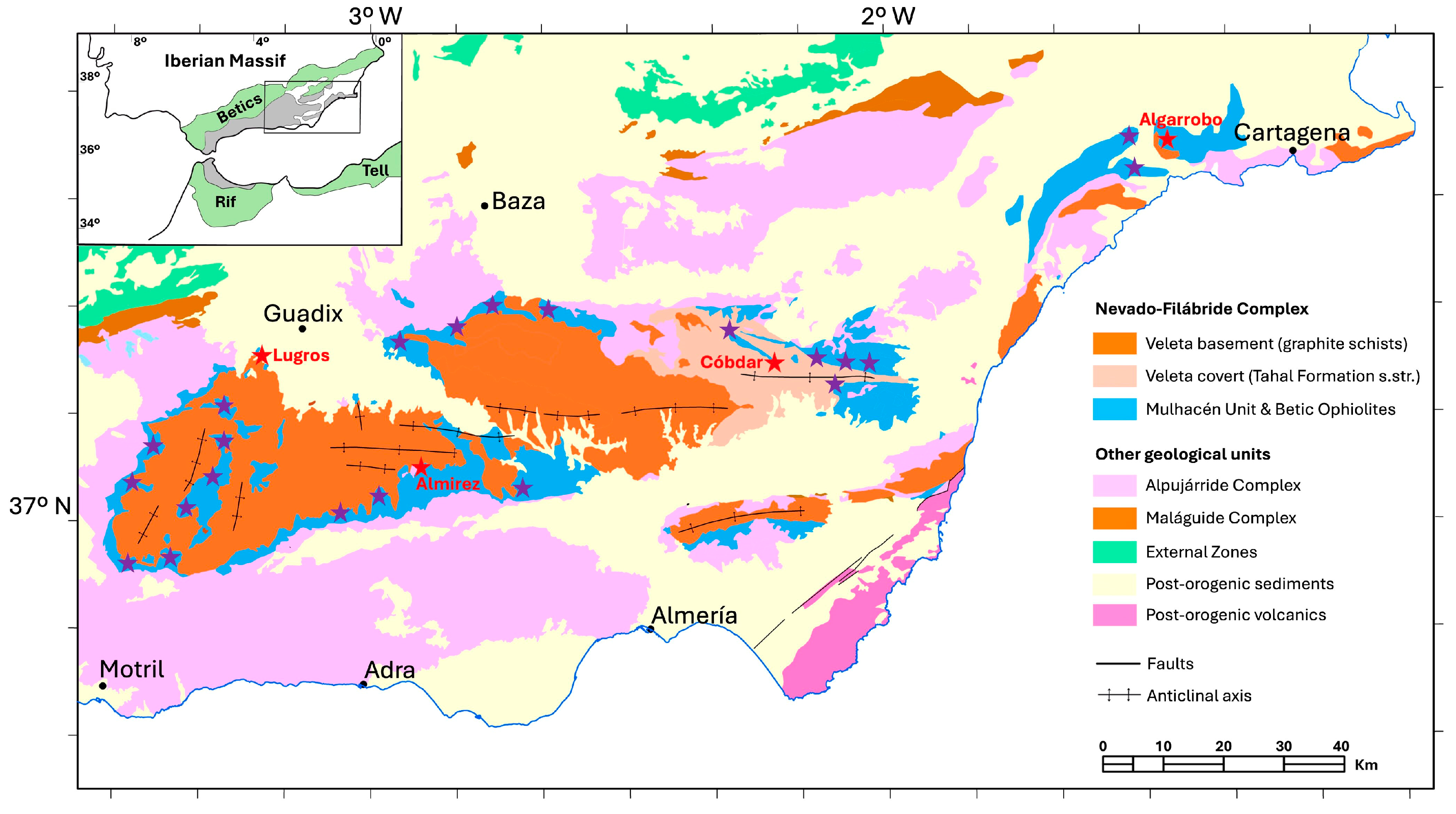

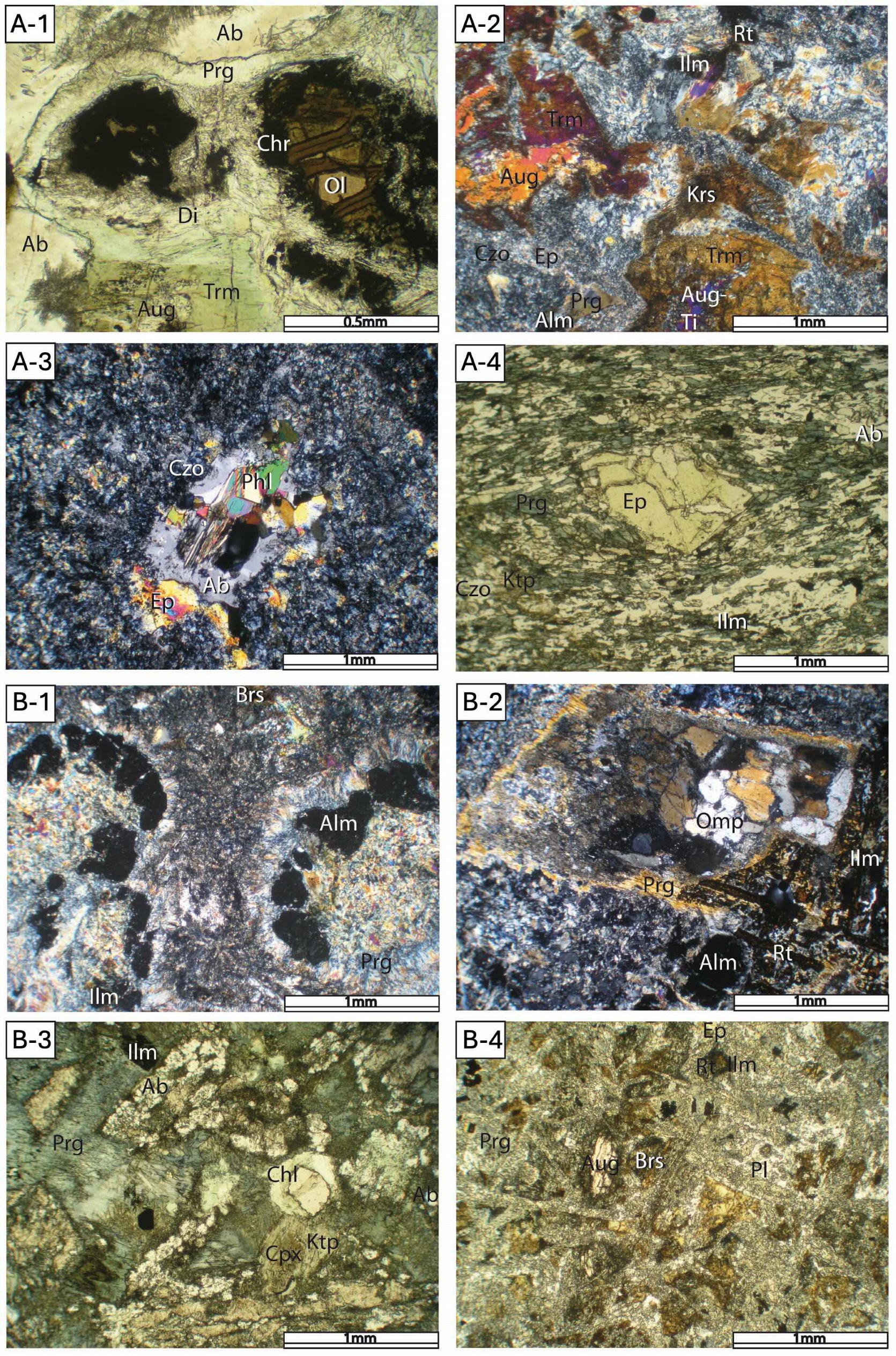
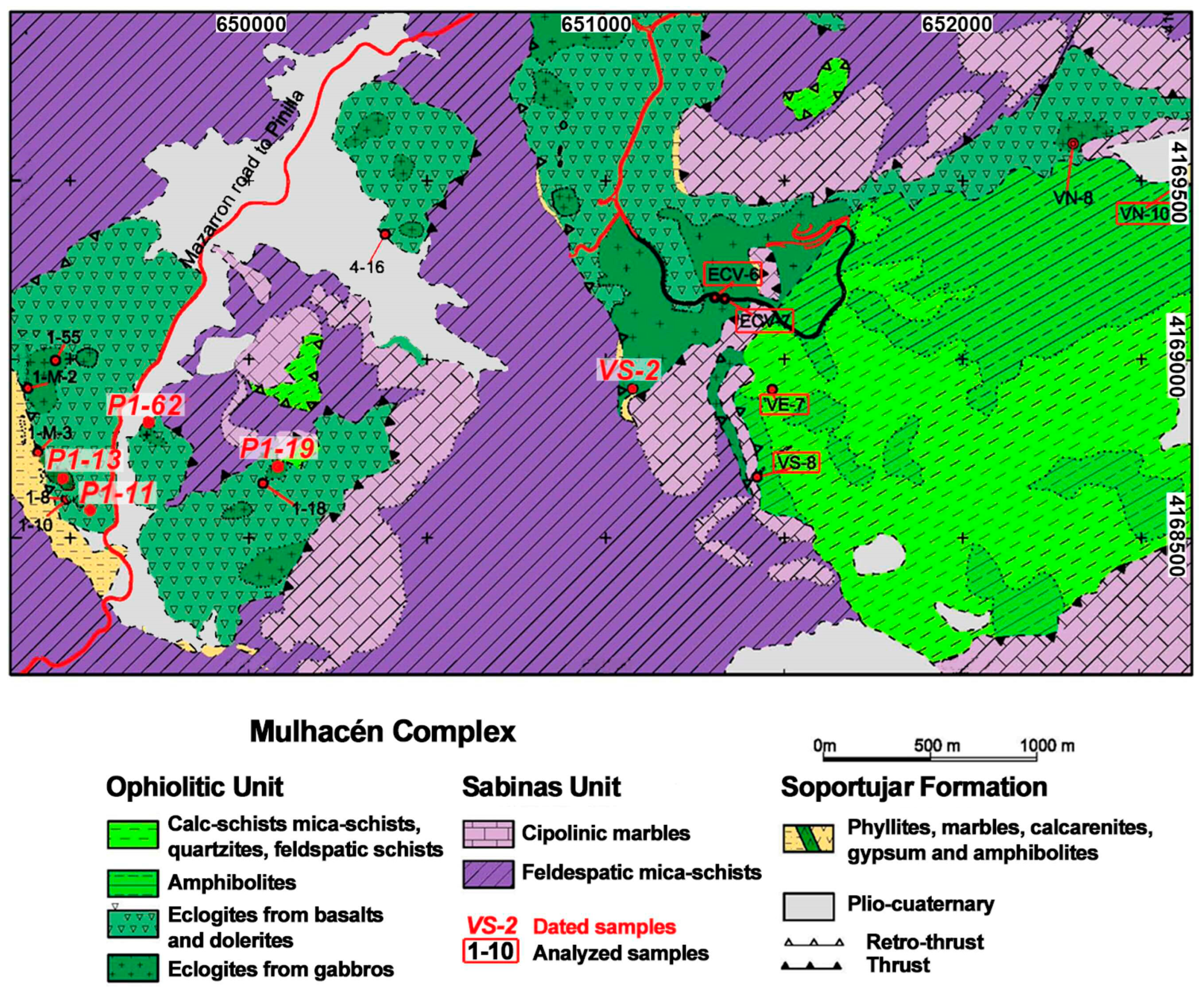
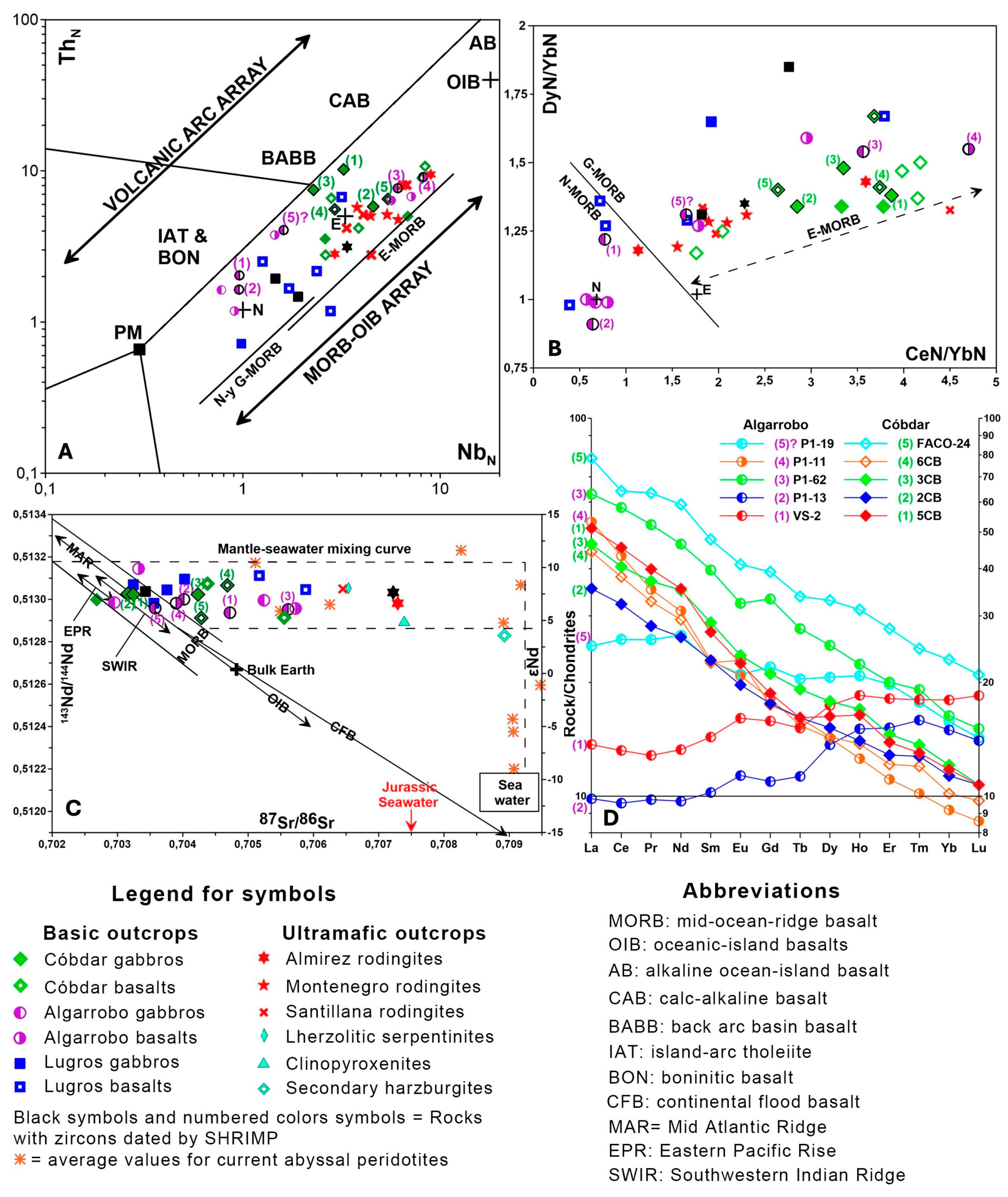
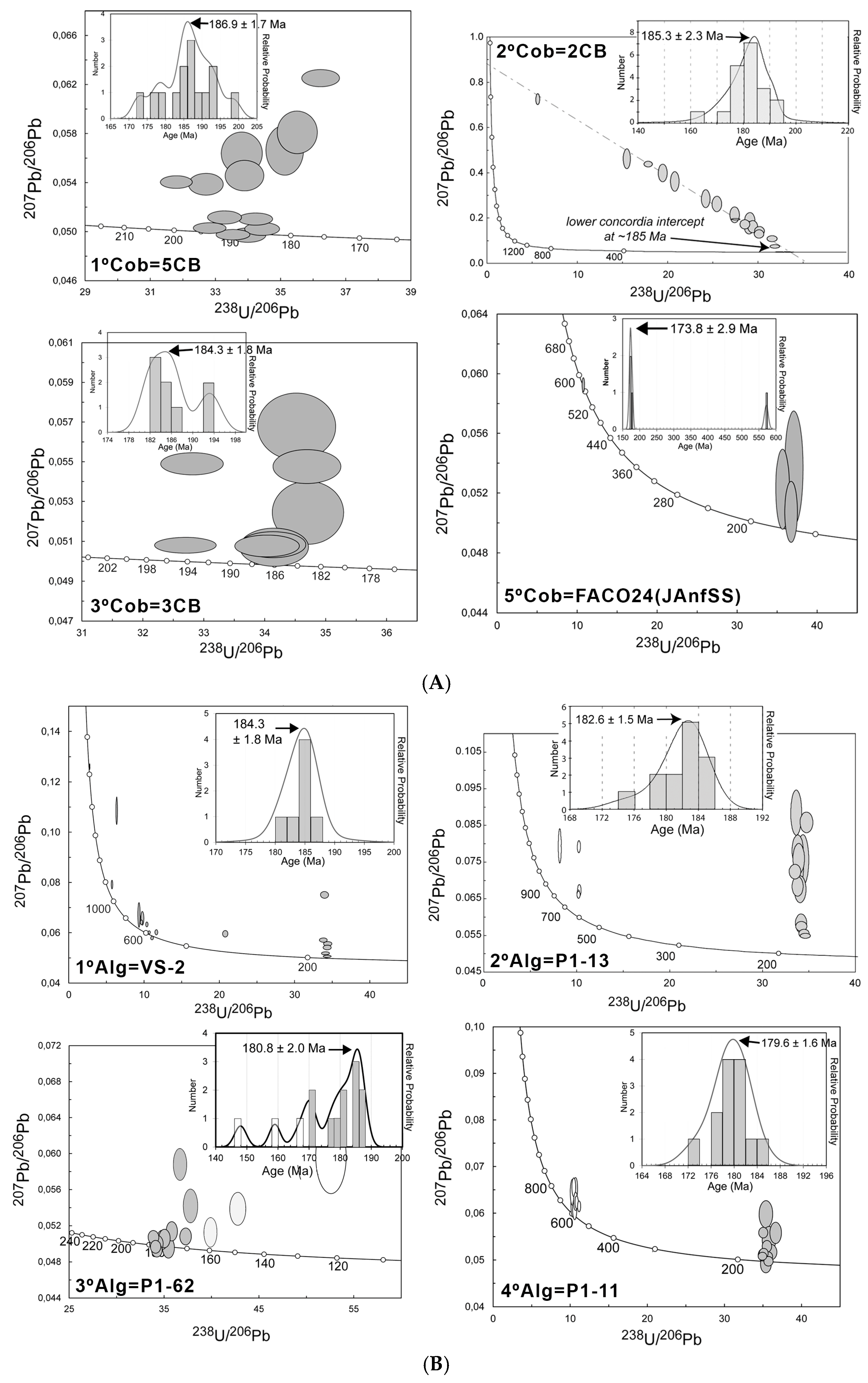
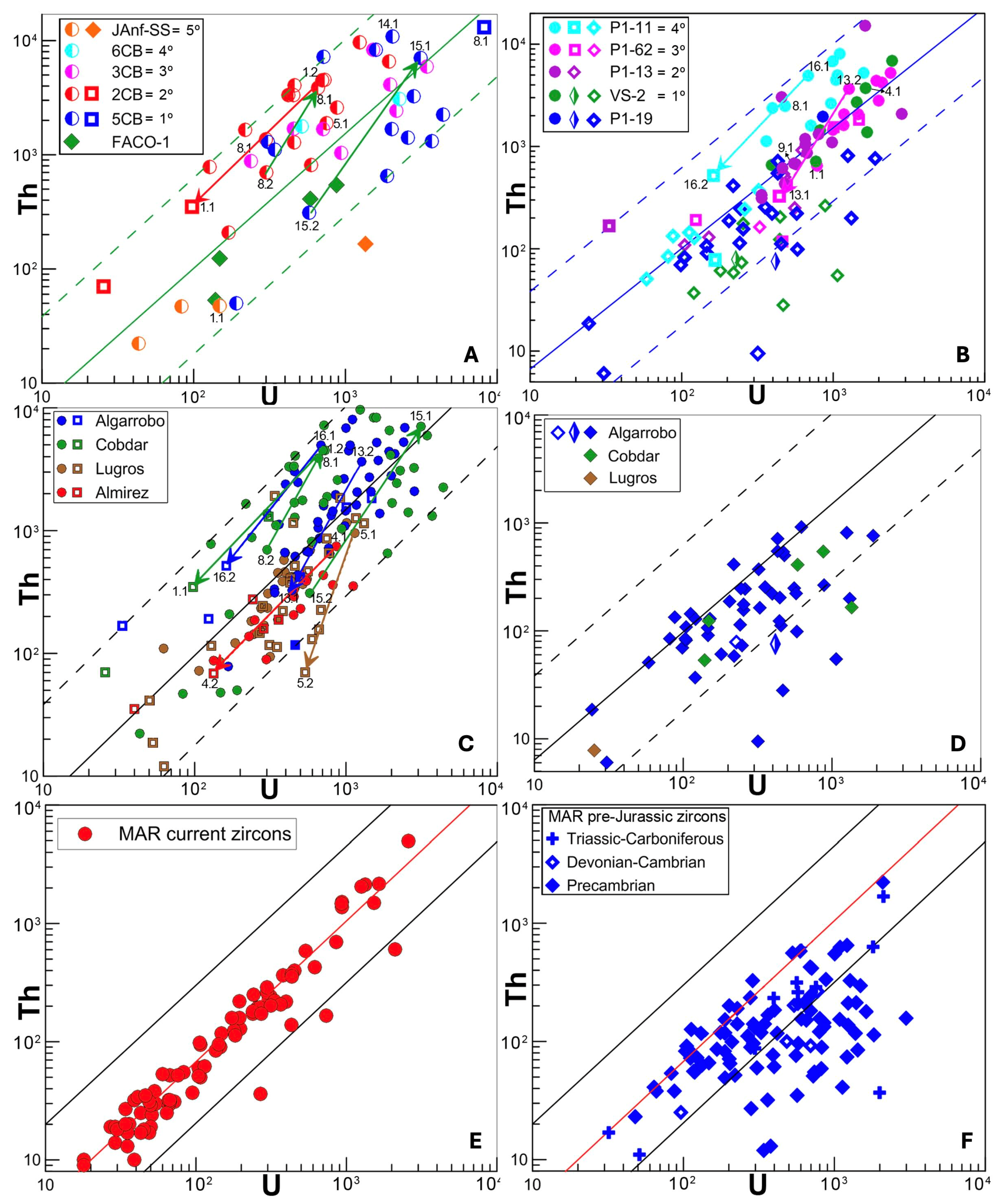
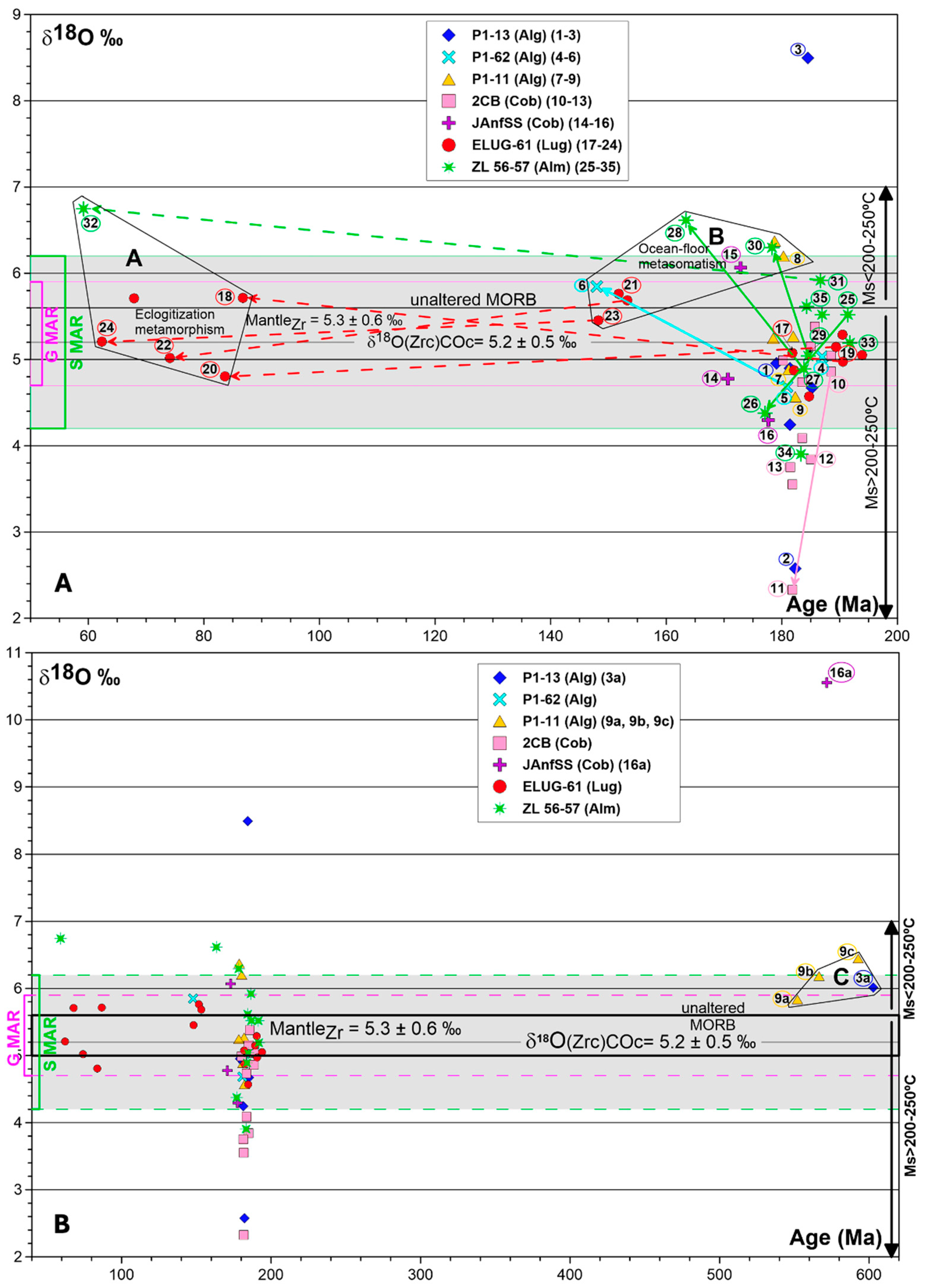
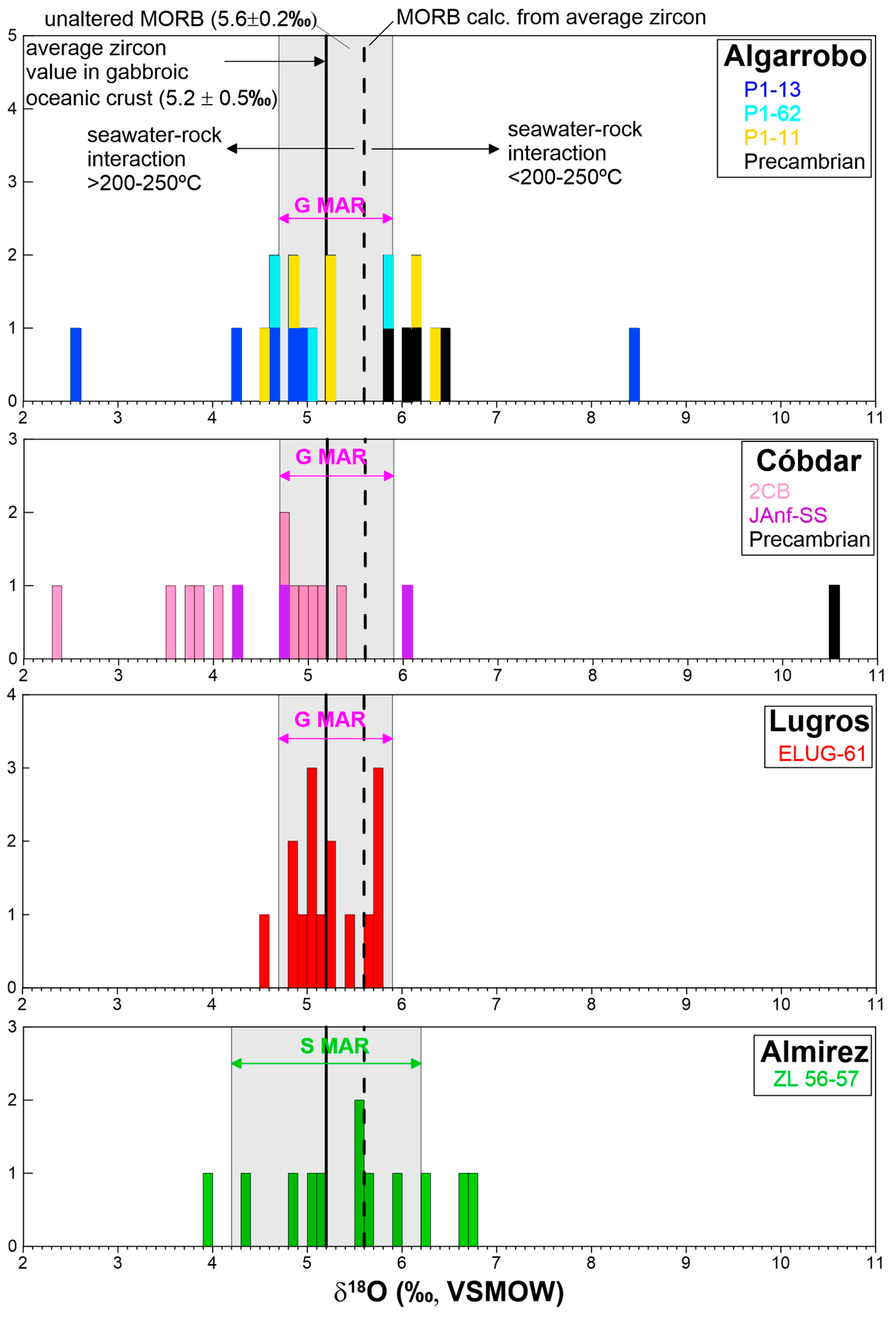
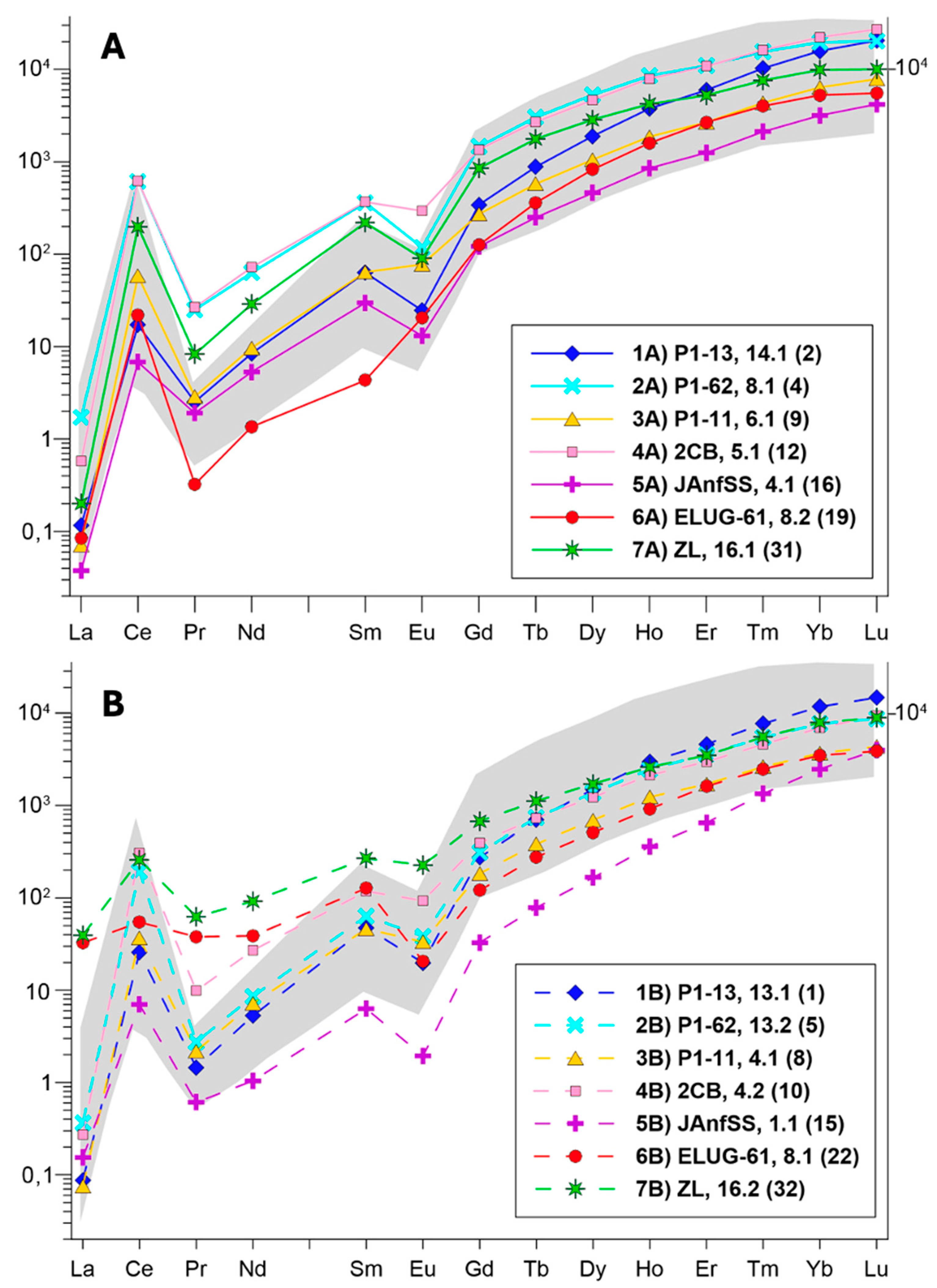
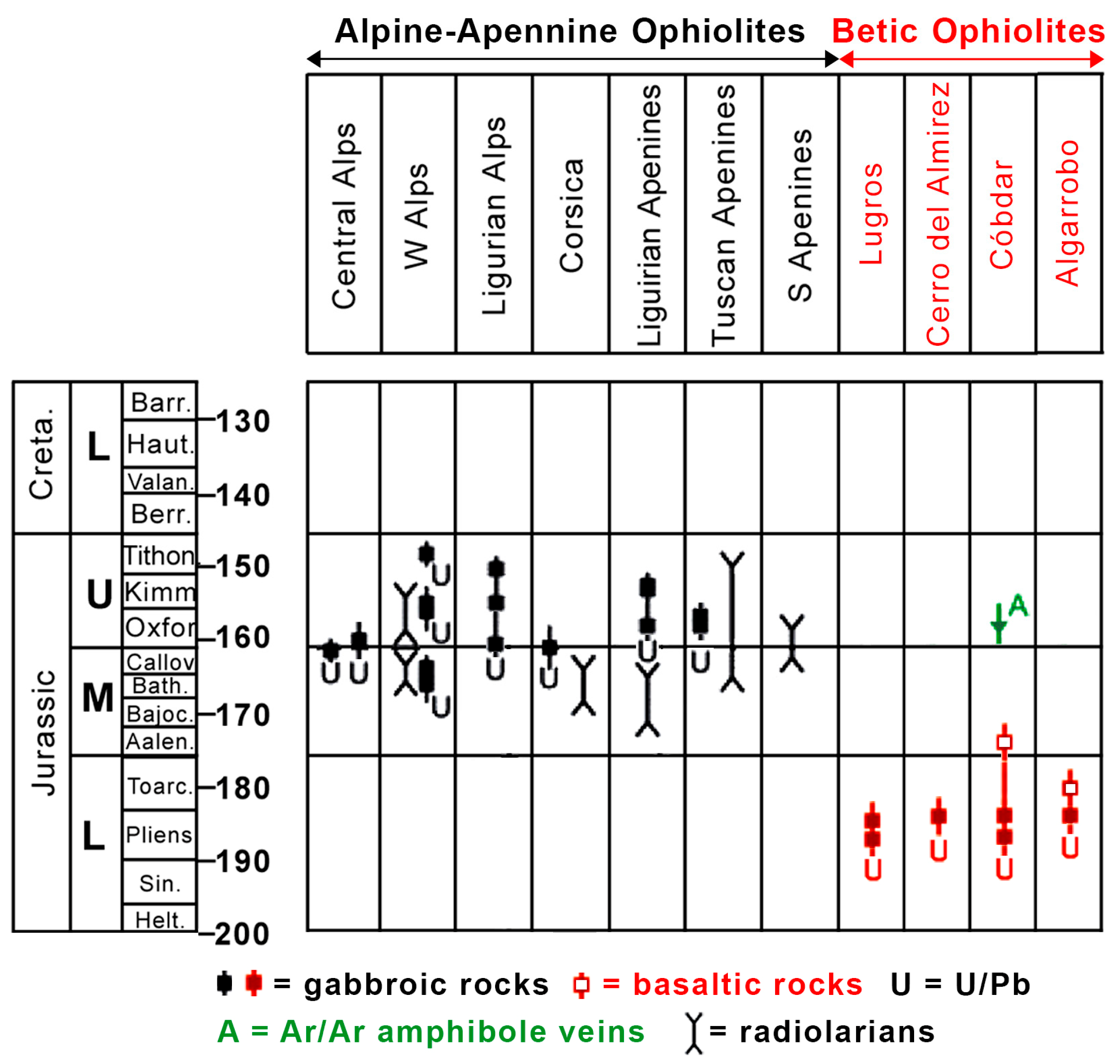
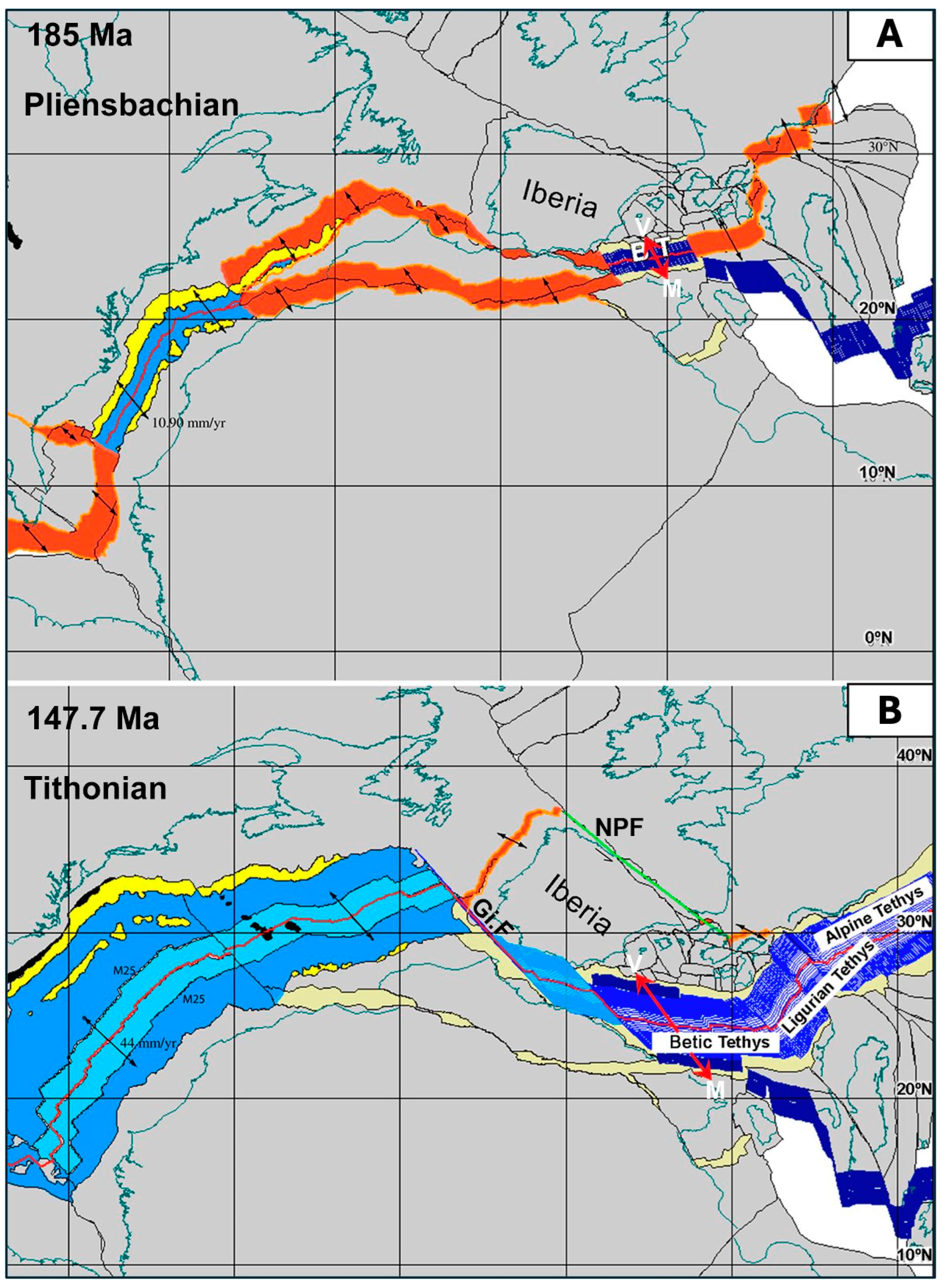
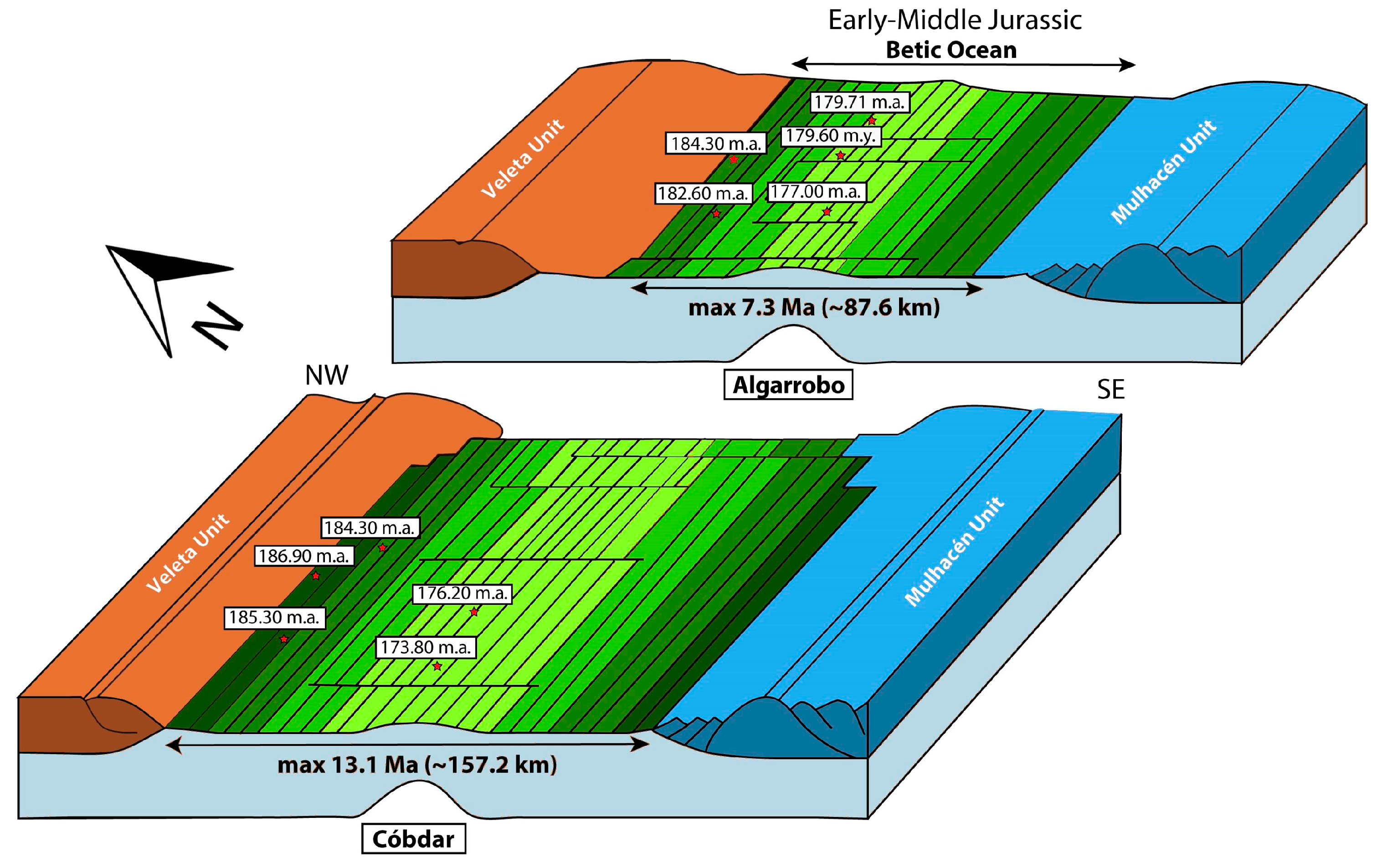

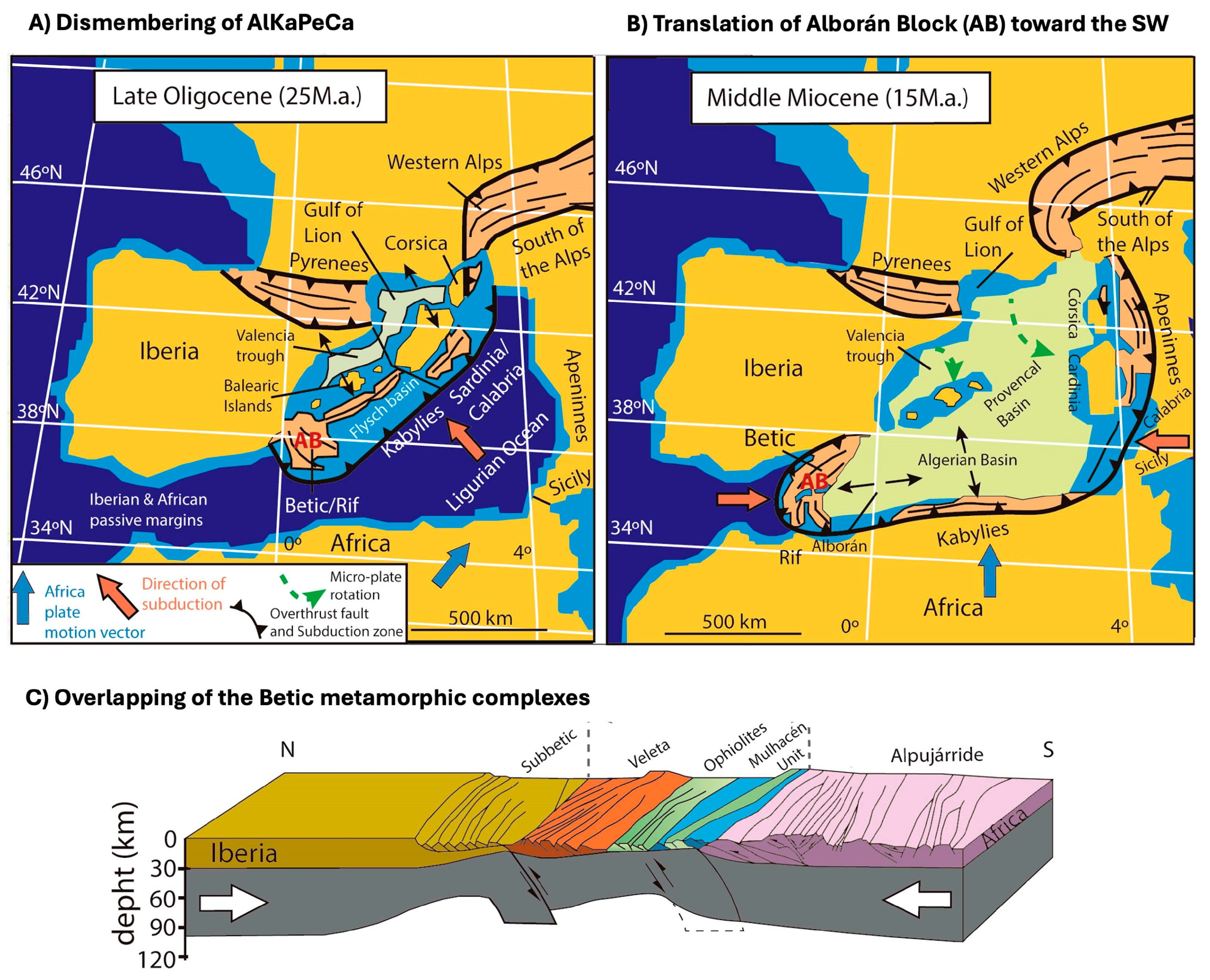
| (A) Cóbdar | |||||||
| Sample | Igneous lithotype | Metamorphic Rock Type | Igneous mineral relics | Ocean-floor minerals | HP minerals | LP minerals | Micro photos |
| 5CB (186.9 Ma.) 14 Zr Jur+1recr. | Ol-Px Gabbro | Amphib.-Eclogite | Ilm, La, Aug | Phlog, Krs | Alm, Omph, Rt | Ab, Ep, Chl, Czo, ClAlMg-Tar, Brs, Mg-Hbl, ClAl-Prg | |
| 2CB (185.3 Ma.) 19 Zr Jur+1recr. | cum.Ol Gabbro | coronitic Ol-metagabbro | Ol(Criso), ClPx(Di-Aug), Ilm, La | br.Amph, Phl, Ap, Prg | Alm, Rt | vaz. Amph, Tr | A-1 |
| 3CB (184.3 Ma.) 8 Zr Jur | Px-Gabbro | Amphib.-Eclogite | Ilm, Ti-Aug | Omph, Alm, Rt, b-gr.Amph | Ep, Chl, Czo, Ab | A-2 | |
| 6CB (176,2 Ma.) 2 Zr Jur | Porphyric Basalt | Ap-Ep Amphibolite | La, Cpx, Ilm | Phl, Ab | Czo, Ab, Omph, Rt | gr. Amph, Carb, Ab, Ed | A-3 |
| FACO-24 (173.8 Ma) 3 Zr Jur./1Zr pre-Jur | Basaltic sill | Ab-Ep Amphibolite | Ilm | Ktp, Prg, Czo, Rt | Ep, Ab, Ms, Carb, Chl | A-4 | |
| (B) Algarrobo | |||||||
| Sample | Igneous lithotype | Metamorphic Rock Type | Igneous mineral relics | Ocean-floor minerals | HP minerals | LP minerals | Micro photos |
| VS-2 (184.3 Ma.) 7 Zr Jur./12 pre-Jur | Ol-Px Gabbro | Amphib.-eclogite | Ilm | Omph, Alm, Rt, Czo | gr. Amph, Ms, Czo, Ab | B-1 | |
| P1-13 (182.6 Ma.) 14 Zr Jur+1 recr./5 pre-Jur | Ol Gabbro | Amphib.-Coronitic eclogite | Ilm, La | Tlc, ClFe-Prg | Alm, Rt, Czo | Brs, Prg, Ep | B-2 |
| P1-62 (181.2 Ma.) 11 Zr Jur+54 recr./1 Zr pre-Jur | PxFe Dolerite | Amphib.-Omphacitite | Ilm | Omph, Rt, Gln, Alm | Prg, Ktp, Ab, Ep | B-3 | |
| P1-11 (179.6 Ma.) 13 Zr Jur/8 pre-Jur | Px Basalt | Amphib.-basalt | Ti-Aug, Ilm | br. Amph, Mg-Hs | bl-gr. Amph, Rt, Czo | Act, Carb, Chl, Tr, Mg-Hbl | B-4 |
| P1-19 (177 Ma.) 1 Zr Jur/23 pre-Jur | Px Gabbro | Amphib.-Eclogite | Ti-Aug, La, Ilm | Omph, Alm, Rt | Prg, Czo, Ab | ||
| Sample | FACO-24 | 2CB | 3CB | 5CB | 6CB |
|---|---|---|---|---|---|
| Lithotype | Basaltic Sill | Ol Gabbro | Px Gabbro | Px Gabbro | Porph. Basalt |
| SiO2 (%) | 49.26 | 46.60 | 48.17 | 47.48 | 47.28 |
| TiO2 | 2.65 | 1.62 | 1.84 | 1.69 | 1.18 |
| Al2O3 | 12.61 | 15.01 | 18.14 | 16.84 | 21.04 |
| Fe2O3 | 9.88 | 10.80 | 9.21 | 8.65 | 7.78 |
| MnO | 0.06 | 0.17 | 0.15 | 0.16 | 0.08 |
| MgO | 1.07 | 12.11 | 4.92 | 9.65 | 3.75 |
| CaO | 11.88 | 8.38 | 9.90 | 8.71 | 11.65 |
| Na2O | 6.79 | 2.52 | 3.51 | 3.03 | 3.42 |
| K2O | 0.06 | 0.62 | 0.77 | 0.82 | 1.05 |
| P2O5 | 0.67 | 0.22 | 0.32 | 0.30 | 0.25 |
| LOI | 4.87 | 0.93 | 2.14 | 1.83 | 1.92 |
| Total | 99.80 | 98.98 | 99.07 | 99.16 | 99.40 |
| Rb (ppm) | 0.8 | 6.2 | 11.0 | 7.8 | 20.3 |
| Sr | 199 | 280 | 363 | 449 | 825 |
| Ba | 4 | 88 | 55 | 153 | 75 |
| Sc | 34 | 25 | 28 | 27 | 18 |
| V | 306 | 182 | 186 | 188 | 151 |
| Cr | 60 | 621 | 173 | 340 | 135 |
| Co | 83 | 97 | 66 | 65 | 71 |
| Ni | 44 | 377 | 65 | 206 | 55 |
| Cu | 36 | 85 | 7 | 38 | 14 |
| Zn | 67 | 90 | 41 | 88 | 20 |
| Y | 50 | 21 | 25 | 23 | 20 |
| Nb | 12.7 | 10.7 | 5.3 | 7.6 | 6.8 |
| Ta | 1.10 | 0.98 | 0.66 | 0.80 | 0.59 |
| Zr | 11 | 93 | 147 | 41 | 43 |
| U | 0.44 | 0.25 | 0.28 | 0.32 | 0.36 |
| Th | 0.78 | 0.70 | 0.90 | 1.23 | 0.67 |
| La (ppm) | 18.57 | 8.39 | 11.01 | 12.12 | 10.51 |
| Ce | 39.29 | 19.73 | 24.79 | 27.82 | 23.27 |
| Pr | 6.02 | 2.68 | 3.52 | 3.79 | 3.11 |
| Nd | 27.63 | 12.31 | 16.39 | 16.53 | 13.69 |
| Sm | 7.31 | 3.50 | 4.41 | 4.16 | 3.45 |
| Eu | 2.38 | 1.14 | 1.37 | 1.30 | 1.33 |
| Gd | 8.06 | 3.61 | 4.34 | 3.85 | 3.58 |
| Tb | 1.26 | 0.60 | 0.72 | 0.60 | 0.60 |
| Dy | 8.38 | 3.85 | 4.53 | 4.13 | 3.65 |
| Ho | 1.76 | 0.79 | 0.96 | 0.93 | 0.78 |
| Er | 4.60 | 2.13 | 2.41 | 2.30 | 2.01 |
| Tm | 0.63 | 0.33 | 0.35 | 0.33 | 0.31 |
| Yb | 3.91 | 1.93 | 2.05 | 2.00 | 1.73 |
| Lu | 0.53 | 0.27 | 0.27 | 0.27 | 0.25 |
| 87Rb/86Sr | 0.0121 | 0.0637 | 0.0880 | 0.0501 | 0.0710 |
| 87Sr/86Sr | 0.704284 | 0.703156 | 0.704233 | 0.703240 | 0.704680 |
| Error | 0.003 | 0.002 | 0.003 | 0.002 | 0.002 |
| 147Sm/144Nd | 0.160000 | 0.171900 | 0.162600 | 0.152200 | 0.152400 |
| 143Sm/144Nd | 0.512912 | 0.513026 | 0.513023 | 0.513023 | 0.513066 |
| Error | 0.002 | 0.002 | 0.002 | 0.002 | 0.002 |
| U/Pb age (Ma) | 173.8 | 185.3 | 184.3 | 186.9 | 176.2 |
| Jur. Zrs | 3 | 19 | 8 | 14 | 2 |
| Pre-Jur. Zrs | 1 |
| Sample | P1-11 | P1-13 | P1-19 | P1-62 | VS-2 |
|---|---|---|---|---|---|
| Lithotype | Px Basalt | Ol Gabbro | Px Gabbro | Px-Fe Gabbro | Ol-Px Gabbro |
| SiO2 (%) | 49.08 | 47.52 | 50.58 | 50.72 | 47.53 |
| TiO2 | 1.62 | 0.86 | 1.69 | 2.24 | 0.98 |
| Al2O3 | 16.88 | 17.83 | 16.22 | 14.99 | 16.08 |
| Fe2O3 | 9.68 | 11.81 | 11.91 | 13.21 | 12.03 |
| MnO | 0.12 | 0.18 | 0.14 | 0.14 | 0.14 |
| MgO | 7.59 | 8.33 | 5.79 | 4.60 | 8.21 |
| CaO | 8.31 | 7.96 | 7.96 | 7.42 | 9.80 |
| Na2O | 3.84 | 2.94 | 3.67 | 4.28 | 2.99 |
| K2O | 0.59 | 0.17 | 0.23 | 0.23 | 0.25 |
| P2O5 | 0.25 | 0.08 | 0.14 | 0.19 | 0.08 |
| LOI | 1.88 | 2.16 | 1.53 | 1.28 | 1.82 |
| Total | 99.84 | 99.84 | 99.86 | 99.30 | 99.91 |
| Rb (ppm) | 10.7 | 8.6 | 3.3 | 1.5 | 5.1 |
| Sr | 511 | 198 | 246 | 417 | 152 |
| Ba | 130 | 135 | 21 | 30 | 11 |
| Sc | 22 | 33 | 47 | 28 | 49 |
| V | 217 | 190 | 266 | 296 | 206 |
| Cr | 396 | 199 | 318 | 175 | 366 |
| Co | 29 | 49 | 31 | 25 | 38 |
| Ni | 117 | 141 | 35 | 27 | 99 |
| Cu | 47 | 93 | 52 | 16 | 42 |
| Zn | 67 | 89 | 71 | 60 | 47 |
| Y | 20 | 25 | 31 | 34 | 29 |
| Nb | 19.1 | 2.2 | 3.8 | 14.2 | 2.7 |
| Ta | 1.41 | 0.60 | 0.34 | 1.05 | 0.27 |
| Zr | 56 | 18 | 23 | 5 | 9 |
| U | 0.42 | 0.10 | 0.13 | 0.52 | 0.10 |
| Th | 1.09 | 0.20 | 0.49 | 0.92 | 0.10 |
| La (ppm) | 12.61 | 2.33 | 5.92 | 14.93 | 3.25 |
| Ce | 26.48 | 5.87 | 15.90 | 35.51 | 8.08 |
| Pr | 3.35 | 0.93 | 2.47 | 4.97 | 1.22 |
| Nd | 14.42 | 4.53 | 12.45 | 21.71 | 6.20 |
| Sm | 3.50 | 1.57 | 3.49 | 6.07 | 2.19 |
| Eu | 1.21 | 0.66 | 1.22 | 1.88 | 0.93 |
| Gd | 3.72 | 2.25 | 4.52 | 6.84 | 3.25 |
| Tb | 0.58 | 0.42 | 0.76 | 1.04 | 0.57 |
| Dy | 3.62 | 3.48 | 5.24 | 6.37 | 4.41 |
| Ho | 0.71 | 0.85 | 1.18 | 1.26 | 1.05 |
| Er | 1.83 | 2.51 | 3.27 | 3.31 | 3.00 |
| Tm | 0.26 | 0.41 | 0.45 | 0.49 | 0.46 |
| Yb | 1.56 | 2.55 | 2.68 | 2.77 | 3.06 |
| Lu | 0.22 | 0.36 | 0.36 | 0.38 | 0.47 |
| 87Rb/86Sr | 0.0605 | 0.1260 | 0.0388 | 0.0104 | 0.0968 |
| 87Sr/86Sr | 0.703897 | 0.704019 | 0.703576 | 0.705610 | 0.704723 |
| Error | 0.003 | 0.002 | 0.003 | 0.001 | 0.002 |
| 147Sm/144Nd | 0.146600 | 0.208900 | 0.169300 | 0.169100 | 0.213900 |
| 143Sm/144Nd | 0.512981 | 0.513000 | 0.512958 | 0.512953 | 0.512937 |
| Error | 0.002 | 0.002 | 0.002 | 0.003 | 0.007 |
| U/Pb age (Ma) | 179.6 | 182.6 | 177 | 180.8 | 184.3 |
| Jur. Zrs | 13 | 15 | 1 | 11 | 7 |
| Pre-Jur. Zrs | 8 | 5 | 23 | 1 | 12 |
Disclaimer/Publisher’s Note: The statements, opinions and data contained in all publications are solely those of the individual author(s) and contributor(s) and not of MDPI and/or the editor(s). MDPI and/or the editor(s) disclaim responsibility for any injury to people or property resulting from any ideas, methods, instructions or products referred to in the content. |
© 2025 by the authors. Licensee MDPI, Basel, Switzerland. This article is an open access article distributed under the terms and conditions of the Creative Commons Attribution (CC BY) license (https://creativecommons.org/licenses/by/4.0/).
Share and Cite
Puga, E.; Díaz de Federico, A.; Díaz Puga, M.A.; Nieto, J.M. Zircon Isotopic Constraints on Age, Magma Genesis, and Evolution of the Betic Ophiolites, Nevado-Filábride Complex, Spain. Geosciences 2025, 15, 406. https://doi.org/10.3390/geosciences15100406
Puga E, Díaz de Federico A, Díaz Puga MA, Nieto JM. Zircon Isotopic Constraints on Age, Magma Genesis, and Evolution of the Betic Ophiolites, Nevado-Filábride Complex, Spain. Geosciences. 2025; 15(10):406. https://doi.org/10.3390/geosciences15100406
Chicago/Turabian StylePuga, Encarnación, Antonio Díaz de Federico, Miguel A. Díaz Puga, and José Miguel Nieto. 2025. "Zircon Isotopic Constraints on Age, Magma Genesis, and Evolution of the Betic Ophiolites, Nevado-Filábride Complex, Spain" Geosciences 15, no. 10: 406. https://doi.org/10.3390/geosciences15100406
APA StylePuga, E., Díaz de Federico, A., Díaz Puga, M. A., & Nieto, J. M. (2025). Zircon Isotopic Constraints on Age, Magma Genesis, and Evolution of the Betic Ophiolites, Nevado-Filábride Complex, Spain. Geosciences, 15(10), 406. https://doi.org/10.3390/geosciences15100406








